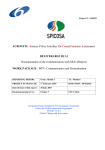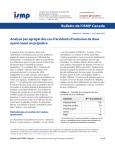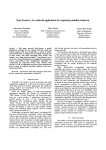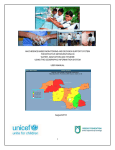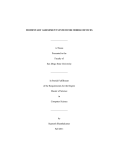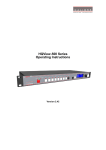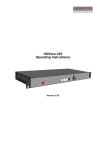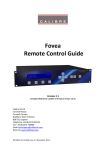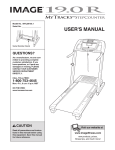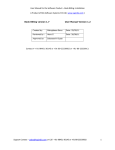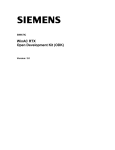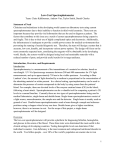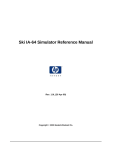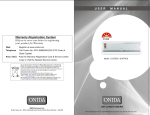Download ICTPH Pre – Clinic Launch Enrolment Process: Deploying a Mobile
Transcript
ICTPH Pre – Clinic Launch Enrolment Process: Deploying a Mobile Phone-based Data Collection Tool in Rural Tamil Nadu Sabyasachi Das, Deepak Rajanna, A.R. Selva Swetha IKP Centre for Technologies in Public Health (ICTPH) Tamil Nadu, India. www.ictph.org.in ICTPH Mobile Enrolment Exercise Introduction IKP Centre for Technologies in Public Health (ICTPH, 2011) is a not-for-profit research organisation with its mission to design inclusive health-systems for remote rural populations, ensuring accessibility and affordability. With its on-ground partner SughaVazhvu (SughaVazhvu, 2011), ICTPH is piloting a technology-enabled comprehensive primary healthcare delivery model in rural Thanjavur in Tamil Nadu. Each of our pilots, referred to as a Rural Micro Health Centre (RMHC), caters to a catchment population of about 10,000 people in a radius of 3-4 km. There is the need for an enrolment process preceding the launch of an RMHC, for the identification and tracking of the population served. This paper details the pre-launch enrolment exercise, where local staff, recruited temporarily, distributed a unique household ID card to every household in the identified catchment and collected demographic information such as the name, age and gender of each family member, and the lat-long co-ordinates of the household using a smart phone running Android OS and a data-collection tool called ODK Collect. The Context To understand the context of the enrolment process, it is important to understand the ICTPH Health Systems Model (Johar, 2010) where the RMHCs anchor multiple functions, focussed on the wellness of the community. Crucial to this approach comprising preventive screening, curative, and community and clinic-based intervention components, is the knowledge of the communities it works in. Provisioning customised services to the rural population encompasses multiple complexities, and essential for the work at hand is a clear demographic understanding of the target geography. The problems the mobile enrolment exercise tries to solve are: 1. Mapping of population served: Accurately mapping the households in the catchment and understanding their geographical distribution in relation to the RMHC. 2. Accurate identification and trackability: Identifying the patient (and her household) when she visits the RMHC seeking care so that electronic health records are mapped to the right individual. Previously, creation of the household database was based on some data on the catchment area captured manually as a one-time exercise. This served as the seed data from which our database would organically grow. However we encountered difficulty, not the least in searching for and correctly identifying the individual on the database, given the lack of standardisation of addresses and the existence of multiple individuals by the same name in same hamlet. Local names could be spelt in a variety of ways, which often resulted in incomplete and incorrect search results. The introduction of a phonetic search function though mitigated this problem to a certain extent, was not completely error-free and was still considerably timeconsuming. Tracking a patient’s episodes through time is essential to our model, and these difficulties pressed the need for a system of unique identification of individuals. 3. Community outreach activities: Enabling our community outreach activities with accurate location information of our target populations. Geo-tagged information will also facilitate distanceoptimisation in the allocation of households to the Health Extension Worker, maximising productivity. Das & Rajanna July 2011 Page 2 of 16 ICTPH Mobile Enrolment Exercise 4. Landscape epidemiology: Building a strong landscape-epidemiological database by accurately correlating geographies with disease determinants, and studying care-seeking behaviour and disease occurrence patterns in their geographical context. At a population level, this data provides valuable insights into the epidemiological statistics of the population being served, which is crucial for a preventive-promotive approach to healthcare. The geo-tagged information would enable the mapping of disease incidence in the catchment area, identification key drivers and trends, the local aetiology of vector-borne infections and targeting community based interventions based on this. For example, high incidence of diarrhoea in a certain geography might call for the implementation of a water quality intervention. The Enrolment Process Launching a new RMHC at Andipatti village, Thanjavur district, the solution consisted of recruiting temporary local staff to perform an enrolment exercise, that included distributing a household ID card, to over 3000 households in the identified catchment and collecting information such as name, age and gender of each of the family members, and the GPS co-ordinates of the household using a smart phone. The complete Enrolment process is laid out in this paper, beginning with the preparation – (tool selection, mapping of the catchment area, recruitment and training of personnel); roll-out – (execution, monitoring, auditing), and the evaluation of the project. PREPARATION 1. Technology Platform In designing the enrolment project it was important to have in mind the alignment of the other processes. The enrolment data was to act as the seed data for other processes such the Population-based Individual Screening Protocol (Johar, 2011), clinic visits, follow-up visits, etc. A range of technology platforms were evaluated before deciding upon Open Data Kit (ODK). ODK presented us with the following advantages: 1. Allows the setting up of own server 2. Ease and elegance of form building (X-forms) - logic building, grouping, etc. 3. No cap on the number of form submissions 4. Allows to capture a range of features like barcode, GPS coordinates 5. Standardisation with Android touch screen phones 6. OpenSource The mobile phone selected for this exercise was the Samsung Galaxy Pop running Android v2.1 OS, each costing about Rs 8500. A GPRS connection, costing Rs 99 per month, was enabled on each of the phones. At the backend, we used ODK's in-built integration with Google Fusion Tables to aggregate all the information. This was then linked to the database of ICTPH’s homegrown Health Management Information System (HMIS) (Rajanna, 2010). The specifics of ODK and the integration with the HMIS are detailed in a Technical Note presented in Annexure 1. Das & Rajanna July 2011 Page 3 of 16 ICTPH Mobile Enrolment Exercise 2. Defining Enrolment Parameters Through the Enrolment exercise, 10 Enrolment Officers, audited daily by 2 Field Supervisors, covered over 3000 households in the catchment area. It was essential to define the enrolment parameters prior to the Enrolment: Household The unit of enrolment was the household. Every household would receive a unique bar-coded ID card. For the purpose of enrolment, we defined a household as distinct from a family. We used the (Government of India Census, 1971) definition of a household as “a group of persons who commonly live together and would take their meals from a common kitchen unless the exigencies of work prevented any of them from doing so”. There could be 2 or more socially connected groups cooking from different hearths, but staying in the same house or boundaries in which case they are considered as 2 different households. This approach allows the households to use the Household Enrolment ID card more effectively. Household respondent: In order that the data collected be accurate, it is important to define clear criteria for a respondent. A household respondent is defined as someone from the household who can represent all the household members. To give it a more objective definition the following criteria were followed: • • • He/she should be above the age of 18 He/she should be integral part of the household He/she should not be a guest Catchment area: In order to lay out the scope of the Enrolment, the catchment area was defined as population patches within a 4 km radius of the RMHC. This area would normally be expected to have 1000015000 individuals. 3. Human Resource Design The surveyors were to be locally hired Enrolment Officers (EOs) from the catchment area. They were commissioned for the duration of the enrolment project. They were typically youth with a minimum of Higher Secondary (Plus-Two Level) Education. The EOs would report to Field Supervisors who were responsible for all technical support and field-based troubleshooting. The field supervisors were permanent staff of SughaVazhvu and also each played the role of an Enrolment Officer during the pilot enrolment conducted in the isolated villages. A Normaliser would play the vital role of covering any remaining isolated population patches where EO allocation would not add any value because of the distance. i.e. a normaliser would work in a hamlet of typically 10-150 households whereas an EO would cover an area of 150-250 households. Unlike an EO who would serially enrol households throughout the day, a normaliser would be expected to travel different geographies to cover all small patches. Das & Rajanna July 2011 Page 4 of 16 ICTPH Mobile Enrolment Exercise The Field Supervisors would also play the role of auditors for quality control. It was their responsibility to administer an audit questionnaire to a sample population, which would be compared with the data collected by the Enrolment Officers to audit the quality of the Enrolment exercise. 4. Enrolment kit A kit was prepared to be sent with each enrolment officer. This Enrolment Kit consisted of: 1. 2. 3. 4. 5. 6. Laminated printout of the Enrolment Protocol Laminated printout of age and date of birth chart Training manual Specially designed jacket and bag Samsung Galaxy pop mobile phone Bar coded ID cards. Figure 1: Household ID Card Format The ID card consists of three parts 1. Household ID: Is a running 4 digit number randomly allocated to households at the time of the enrolment process. Since an RMHC caters to a population of about 3000 households, a 4-digit number suffices. 2. Barcode: The household number is also encoded as a barcode on the ID card. The symbology used was code 128 A, because it was found to be optimal for use with a low resolution camera that comes installed in mobile devices. 3. Picture: All the textual information contained in the ID card was saved as a picture in order to preserve formatting during the printing process. The ID card contains the address of the RMHC and also mentions the services offered there. 5. Audit Design Daily audits would be made to ensure quality of data collected by the enrolment officers. A printed sheet would be given to the field supervisors every day which consisted of audit parameters of data collected the previous day. These households for audit were picked either Das & Rajanna July 2011 Page 5 of 16 ICTPH Mobile Enrolment Exercise randomly with a back-end platform or using the GPS maps in case of any discrepancy in the map. Figure 2: Daily Enrolments by Agent with a provision to mark for Audit The Audit Questionnaire is contained in Annexure 2. 6. Monitoring and Evaluation Design Monitoring and evaluation are integral to ensuring the accuracy and reliability of the data, and were done in the following ways: GPS maps: Daily check on the GPS map allows monitoring of the entries real-time. Each enrolment officer would be marked separately on the map to monitor any overlaps in allocated area, overcrowding of GPS tags from one location or a household etc. Audit results: The audit results would allow us to give constructive feedback to the enrolment officers both on the quality of the data and other subjective parameters. Real-time fetching: Real time fetching of data to our server allows monitoring performance of the EOs against their individual targets. As part of the data collection exercise we realised the need for tracking the progress real-time and for monitoring the quality of data being sent up to the servers. A dedicated dashboard was built in the HMIS to track the data collection. Das & Rajanna July 2011 Page 6 of 16 ICTPH Mobile Enrolment Exercise Figure 3: A dedicated dashboard was built into the HMIS to enable the project manager to detect any process flaws and correct them quickly. Annexure 3 shows the various modes of feedback that the dashboard was designed to provide. PROCESS FLOW 1. Catchment mapping We had no satellite map of Andipatti available to us, and this threw the challenge of identifying the villages and population patches in the catchment area from limited resources. Block Development Offices (BDOs) and Taluka Office have basic block level maps of village Panchayats in the block1. This is a good starting point to broadly decide on the villages that fall under the catchment area. The next step was to create a detailed catchment area map by physically identifying all population patches within a 4 km radius area of the RMHC. A tracking software http://mytracks.appspot.com/ on an Android phone was used to draw route trails and locate points in all the population patches. Small isolated patches of as small as 20 households’ size were also GPS mapped and named in this exercise. Street Mapping Once a detailed population patch map was ready, the next step was to identify all the streets in the various villages. Identification of streets is a very important step in order to pre-populate the list of street names in the ODK form and assign each to the respective village. This eliminates the possibility of spelling errors and also reduces time spent in entering the address. 1 See http://www.indiadevelopmentblog.com/2008/04/one-small-step-closer-to-englightenment.html for details of the system of local self government in India and its administrative boundaries. Retrieved July 2011. Das & Rajanna July 2011 Page 7 of 16 ICTPH Mobile Enrolment Exercise The street information was collected from different resources like village Panchayat offices, village post offices, and local resource persons. These street names were verified by physically visiting the places. A printed sheet was given to the field coordinators to capture basic village information. Population size and area allocation Knowing the population of each village or population patch is important to allocate human resources to carry out the enrolment. The size of the population was collected from Census 2001 register provided by the village offices of the Panchayat. This information was used to identify unique clusters of households that would determine the number of enrolment officers. Logical boundaries were drawn so that enrolment officers do not have overlaps in their allocated areas. . A geographical boundary in this context is defined any uninhabited patch like river, road, field etc. which demarcates one allocated group of population with another. In the case of Andipatti the villages where classified as either 1 EO per village (usually 200 household size) or 2 EOs per village (usually 400 household size). In case of 2 EOs per village size the village is demarcated by a geographical boundary as given below. Figure 4: The above given Google map shows a sample village (Pachiyur) from the Andipatti Enrolment project where geographically demarcated areas are marked in different coloured dots. The green dots represent GPS coordinates of households captured by one particular EO whereas blue dots represent another EO. In this case the road dividing the village into two halves acts as an ideal geographical boundary. 2. Recruitment and training: Using ads in local newspapers and announcements in the village, we recruited 10 enrolment officers. Since many of the enrolment officers were not used to smart-phones we trained them on using the new devices by performing supervised mock-enrolments with each other. The training Das & Rajanna July 2011 Page 8 of 16 ICTPH Mobile Enrolment Exercise also included soft-skills orientation in order to ensure uniformity in the messaging when the officer communicates with the catchment population. The Recruitment and Training is given in detail in Annexure 4. 3. Testing The entire enrolment comprised of 3 phases- Pilot, Phases I & II. The first was an internal pilot where future Field Supervisors played the role of Enrolment Officers where they got to know the entire process to enable them to supervise the Enrolment Officers better. This pilot covered only small isolated population patches (each of population of about 44 households) were covered. Isolated population patches were chosen to get operational insights without intimidating a larger community. The goal was to successfully complete the entry of at least 120 HHs in 3 days’ time. Figure 5: The diagram shows the Satellite map merged with GPS coordinates of different isolated population patches considered during the internal pilot. The yellow circle indicates an area of radius 0.5 km. 4. Roll-Out We adopted a two-phased approach to the Enrolment process in order to organically induct Field Supervisors on project management and technical trouble shooting. In Phase 1 only a radius of 1.5 km from the RMHC was covered whereas in Phase 2 the remaining radius of 1.5 - 3 km was covered. Das & Rajanna July 2011 Page 9 of 16 ICTPH Mobile Enrolment Exercise Figure 6: The diagram shows the Satellite map merged with GPS coordinates of different population patches covered in the Phase 1 and 2. The yellow region indicates an area of radius 1.5 km. covered in Phase 1 and the red region indicates the area covered during the Phase 2. Technical support and field supervision The field supervisors were responsible for providing technical support to the enrolment officers. The EOs reported to them twice a day. The first reporting would be at 9:30 am where the EOs would collect the charged mobile phones and ID cards and communication materials for the day. The second reporting would be at 5:30 pm when the enrolment officers would hand over the phone to the field supervisors for manual Wi-Fi fetching (In case the data is not sent via GPRS. As per our experience 20% of the total data required manual syncing) data fetching and have them charged and ready for the next day. Targets and compensation There is no existing benchmark as such for the compensation for this kind of role and varies highly depending on the geographies. We looked at the NREGA (National Rural Employment Guarantee Act)2 rates of Rs.150/- per day as a comparable standard, and assumed a minimum of 10 household enrolments a day at the rate of Rs.15/- per enrolment. We incentivised the enrolment officers using 2 pay buckets: 1. 10-15 households would fetch Rs.15/- per household enrolment 2. 16 and more households would fetch Rs.20/- per household enrolment 2 http://nrega.nic.in/netnrega/home.aspx Das & Rajanna July 2011 Page 10 of 16 ICTPH Mobile Enrolment Exercise The difference between the two buckets was incentive enough to motivate the enrolment officers to strive to be part of the second bucket. Within a quick span of time the enrolment officers started completing an average of around 30 household enrolments per day which earned them around Rs.450/- per day on average. Annexure 4 contains the MoU signed with the EOs, containing terms and conditions related to minimum targets, compensation, hardware ownership, reporting and training structure, in order to bring transparency into the process. Monitoring and evaluation GPS based feedback At the backend, ODK was integrated with Google Fusion Tables so that all the data collected was monitored real-time. The dashboard captured the relative performance of each of the officers and also helped review the quality of the captured data. Mapping the GPS coordinates collected by enrolment was a good way visually monitoring the enrolment process on a daily basis. Mapping the enrolment information on to a real-time map also ensured that no officers strayed outside their own allocated boundaries. Figure 7: The green and blue markers represent two different enrolment officers who were allocated two sides of the same village (Karrukkadipatti) where the geographical separator is the main street. GPS monitoring enabled identifying and rectifying the overlap immediately. Risk Audit A small portion of the previous day's enrolments - about 5% - were selected for a daily audit that was performed by the field supervisors. The audit questionnaire was designed to catch any falsification of data and also to ensure that the officers were courteous. Das & Rajanna July 2011 Page 11 of 16 ICTPH Mobile Enrolment Exercise Weekly feedback and Payouts The enrolment officers were given weekly feedback, sharing the result of the enrolment done during the week. Sharing of GPS maps of the household enrolled, targets and enrolment progress, weekly consolidation of the audit results etc. would be a part of the feedback session. A graphical representation of the comparison between different enrolment officers in the payout sheet built a culture of healthy competition both in terms of quantity and quality of the data collection. (Annexure 6) OUTCOMES AND PROJECT EVALUATION Andipatti Summary Figure 8: An Age-breakdown of the enrolled Andipatti population Total number of individuals in the catchment area: 12,435 Males: 6196 Females: 6218 Such demographic information would enable us in targeting our specific interventions at the relevant sub-population: Cardio Vascular Disease Intervention (age range 35-64): 4,206 Sprinkles Infant Nutritional Supplementation (infants 0-24 months): 403 Cervical Cancer (Females in the age range 30-50 yrs): 1,833 Das & Rajanna July 2011 Page 12 of 16 ICTPH Mobile Enrolment Exercise The GPS data collected during enrolment also helps understand the effect of distance on patient traffic: Figure 9: The map on the top shows all the households mapped in the Andipatti enrolment exercise, and the one below shows all of those households that have made at least one visit to the RMHC. 51 of the 102 households we mapped in Andipatti village – which is 50% - had sought our services in the first month of the clinic’s operations. As we go further out Mudalipatti and Athanangkottai are at 30% and 20% respectively. On the other end of the spectrum are Chellampatti and Pachiyur, both of which are far out on the north-west corner of the visible map; no one from the 250-odd households we registered had come to our RMHC. Das & Rajanna July 2011 Page 13 of 16 ICTPH Mobile Enrolment Exercise Progress mapping Figure 10: The graph of the actual progress of the Enrolment Project against the expected progress. The Enrolment exercise was completed about half the expected time. Project Evaluation Parameters While designing the project the evaluation parameters were defined in order to track progress and evaluate the project in its dynamic states. Some of the important evaluation parameters are discussed below: 1. Timely completion Since enrolment precedes the clinic launch and thereafter the other health interventions completing it within a rigid timeframe is important. A progress plan chart was prepared against which we could track the timelines. 2. Human resource utilisation Working in rural India, human resource is a challenge. This project tried to leverage local resource that also brings with it understanding and familiarity of the geography, and also helps cultivate trust amongst the local community. Local personnel were selected as Field Supervisors from within the organization that went through a one-day project management and training session. Das & Rajanna July 2011 Page 14 of 16 ICTPH Mobile Enrolment Exercise 3. Project cost CAPEX Unit cost No. Total cost Mobile phones 8500 11 93500 Bags 120 11 1320 Jackets 450 8 3600 Prints 350 11 3850 102270 OPEX Unit Cost No. Total Cost Salary for EO 20 3000 60000 Salary of Field Supervisors 3667 3 11000 Bike rent 2000 1 2000 Travel cost and food 1000 3 3000 76000 4. Data quality Data quality was maintained by the continuous matching of a sample of the enrolment data with the audit data. The results of the data audit were very reassuring. Conclusion In this paper we have set out the entire end-to-end pre-clinic-launch enrolment process, whereby the demographic details and the GPS coordinates of all the households in the catchment area are collected using Android mobile phones. The entire enrolment exercise was completed in less than 15 days with fairly good quality, capturing information on about 3000 households consisting of nearly 13000 individuals. This experience proved to be repeatable when we replicated this activity at another pilot, Alakudi, in less than 10 days, for nearly half the cost (Rs. 10 per household enrolled in Alakudi, as opposed to Rs.20 at Andipatti). The data collected from the exercise was fed into the HMIS before the RMHC operations began and the usage of ID cards immediately proved an improvement over the earlier method of identification (based on name search). The systematic enrolment process also served as a good marketing exercise since it reached every household in the catchment. Das & Rajanna July 2011 Page 15 of 16 ICTPH Mobile Enrolment Exercise Bibliography Government of India Census, Census Terms. http://censusindia.gov.in/Data_Products/Library/Indian_perceptive_link/Census_Terms_link/cens usterms.html. Retrieved July 2011. Google AppEngine http://code.google.com/appengine/. Retrieved July 2011. Google Fusion Tables http://www.google.com/fusiontables/public/tour/index.html. Retrieved July 2011. ICTPH http://www.ictph.org.in/ . Retrieved July 2011. Johar, Z. (2010). ICTPH Health System Approach. Retrieved July 2011, from ICTPH: www.ictph.org.in/downloads/ICTPH-Health-Systems-Note-Johar-26-10-10.pdf Johar, Z. (2011). ICTPH Population based Individual Screening Protocol. Retrieved March 15, 2011, from http://www.ictph.org.in/downloads/ICTPH%20Population%20based%20Individual%20Screening %20Protocol.pdf Open Data Kit http://opendatakit.org/. Retrieved July 2011. Rajanna, D. (2011). Health Management Information Systems - A Technical Note. Retrieved July 2011, from ICTPH: www.ictph.org.in/downloads/HMIS-TechnicalNote.pdf Rhiza Labs http://rhiza.com/. Retrieved July 2011. SughaVazhvu Healthcare http://www.sughavazhvu.co.in/. Retrieved July 2011. XForms http://www.w3.org/TR/xforms11/. Retrieved July 2011. Das & Rajanna July 2011 Page 16 of 16 ANNEXURE 1: Technical Note Data Collection - Technical Note Open Data Kit Open Data Kit (ODK) is an open source platform for mobile data collection that provides a standard way of defining and rendering forms using the XForms specification. Four separate components from the ODK suite come together to form a data collection solution. ● ● ● ● ODK Build provides a wizard for defining a form for including basic data validation and branching logic. ODK Collect is an application that runs on the mobile phone rendering the form and uploading data back to the server. ODK Aggregate is the server component that stores the form responses submitted through the mobile phones. ODK Validate is an offline tool that allows a user to validate manually generated Xforms. Figure 1.1: ODK consists of components for building forms (Build), rendering them on mobile phones (Collect) and storing the responses (Aggregate). Das & Rajanna July 2011 Page 1 of 2 ANNEXURE 1: Technical Note HMIS Integration Survey responses from multiple mobile phones are collated in the server component, ODK Aggregate. Aggregate is based on the Google AppEngine framework which includes a basic hosting service for free. Aggregate comes with scripts as well as documentation that make it effortless to deploy. Once deployed, Aggregate allows for external data access through various modes, such as integration with Google Fusion Tables, Rhiza Insights and Google SpreadSheets. We chose Google Fusion Tables for the backend integration because of its support for graphical visualization and welldocumented programming APIs. Once the enrollment agents start filling the surveys and sending them to ODK Aggregate, the responses are also automatically pushed into Fusion Tables in a tabular form that allows for instant visualization, filtering and basic error checking. Using the programming interface, the ICTPH Health Management Information System (HMIS) access this data using the programmer interface and populates its own databases. Figure 1.2: Google Fusion Tables was used as an intermediary between ODK Aggregate and HMIS because of its well-documented programming interface. Das & Rajanna July 2011 Page 2 of 2 ANNEXURE 2: Audit Questionnaire Final Risk Audit on ODK Screen display Type Drop down Auditor no. Check if anyone visited HH from Sughavazhvu? Check if HH recieved a ID card, if yes, could I look at it Drop down Scan the bar-code Drop down Bar-code scan Check if respondent matches the criteria Drop down Check if the address is correct Capture no. of family members Drop down Numeric Check if the EO explained about SughaVazhvu Drop down Check if the EO was friendly Drop down Das & Rajanna July 2011 Options 1,2 Yes, No, Don't know Yes, No, Don't know Yes, No, Don't know Yes, No, Don't know Yes, No, Don't know Yes, No, Don't know Page 1 of 1 ANNEXURE 3: HMIS Dashboards for Monitoring Mobile Data Collection Dashboard Figures 3.1 to 3.6 show the various modes of feedback that the dashboard was designed to provide. Figure 3.1: A day-wise breakup of enrolments count allows the project manager to track daily output. Figure 3.2: A report of enrolments done during various times of the day indicate if there were any stoppages or reduced throughputs at any particular time. Das & Rajanna July 2011 Page 1 of 5 ANNEXURE 3: HMIS Dashboards for Monitoring Figure 3.3: Agent-wise counts of enrolments were important to deliver targeted feedback to the surveyors to ensure that expected targets were continuously achieved. Figure 3.4: Mapping enrolments over a map also indicated whether agents were crossing allocated boundaries and also to ensure comprehensive coverage in the catchment areas. Das & Rajanna July 2011 Page 2 of 5 ANNEXURE 3: HMIS Dashboards for Monitoring Das & Rajanna July 2011 Page 3 of 5 ANNEXURE 3: HMIS Dashboards for Monitoring Figure 4.4 (On previous page): Tracking the progress of enrolment agents on the map gives feedback on the adherence to plan. This figure tracks the progress of one of the surveyors over three days. This information is useful in optimizing the area allocation and to determine direction of surveys. Figure 3.5: It was important for the dashboard to indicate the progress for each of the villages in the catchment to determine optimal allocation of resources over geographies. The blue lines in this chart indicate the approximate number of households as estimated by the state census (2001) and the green indicates the actual number of households enrolled. Das & Rajanna July 2011 Page 4 of 5 ANNEXURE 3: HMIS Dashboards for Monitoring Figure 3.6 (On previous page): The initial estimate of this enrolment project is indicated by the grey line; an estimated 2000 households were planned to be covered over a span of 22 days. The redline indicates the actual enrolment numbers; 3033 households were targeted over roughly 18 days, including a pilot phase of 4 days in which only three in-house enrolment agents covered nearly 200 households (as indicated by the initial low-gradient of the red line). Das & Rajanna July 2011 Page 5 of 5 ANNEXURE 4: Recruitment and Training Interview and EO candidate screening Date: 22 March, 2011 Time: 10:00 am to 6:00 pm Venue: SughaVazhvu RMHC, Andipatti Interviewer: Sabyasachi, Rathinam, Alexander Expected no. of Applicants: 30-40 candidates nd Selection Phases Preliminary Interview Responsibility Group A Rathinam Rathinam Induction Lunch Break (Lunch will be provided to all candidates) Group A Training Duration Group B 1 hour Time 10:00Alexander 11:00 11:001 hour 12:00 Group B 14:00Alexander 2 hours 16:00 16:00Sabyasachi+Rathinam+Alexander 2 hours 18:00 Rathinam Exam and Final Selection The objective of the interview is to identify appropriate candidates for Andipatti Enrolment project. A total of 13 candidates will be selected from a large pool of applicant (for spot registration candidates application form will be complete). The screening process is divided into 4 phase as following: Preliminary Interview: This is a short face to face interview with the candidate where scoring will be given as follows: Marks on Checks Question 10 Weightage Scores Confidence level of the candidate Communication skills of the candidates Proficiency in reading and writing English His HH location and distance of our catchment village His interest level to do this Enrollment Education level Do you think you can learn to use our mobile application within a day? What kind of work you like to do? Ask the candidate to write his and his father’s name. What is the meaning of brother in law/daughter in law etc.? Ask him where he stays and match it with our Map What do you know about SughaVazhvu so far? <10th-4; 10th-5; 10+2-6; Diploma-7; graduation-8; masters-9 10 5 50 10 8 80 10 8 80 10 6 60 10 8 80 10 5 50 100% The above table is only a sample scoring sheet. Das & Rajanna July 2011 Page 1 of 6 ANNEXURE 4: Recruitment and Training Induction: The induction will involve: 1. 2. 3. 4. 5. 6. 7. 8. 9. Introduction to SughaVazhvu Objective of the Enrollment What are the expectation from an Enrollment Officer (EO) Duration and minimum daily targets Compensation for correct and complete entry Certification Reporting structure in brief Important dates Selection parameters, MoU and waiting list provision Training and Mock Practice: Training will be provided on the following subjects: 1. 2. 3. 4. 5. Visit/Enrolment Protocol Communication to the Household about SughaVazhvu Mobile usage, technical support- Mobile usage Practical Reporting protocol to Fields Supervisors Exam and Final Selection: 3 successful entries of HH (dummy) using ODK-Samsung apps are required. The candidates will be divided into 2 groups. One will play a role of an EO and another group as HH Respondent. The entire process and candidates conduct will be observed by the interviewer during this mock practice and scored accordingly. Das & Rajanna July 2011 Page 2 of 6 ANNEXURE 4: Recruitment and Training Agreement between SughaVazhvu Healthcare and Enrollment Officer This MOU is entered into on 23th March 2011 BETWEEN SughaVazhvu Healthcare Private Limited, a company incorporated under the Companies Act, 1956 and having its registered office at A2, L.P. Amsavalli Illam, 7th Cross Street, Arula Nanda Nagar, Thanjavur, Tamil Nadu- 613007 (hereinafter referred to as "SughaVazhvu" which expression shall whenever the context so admits includes its authorized assigns and successors in title of the FIRST PART. AND Mr/ Ms.............................................................................................................................................................................. Son/Daughter of .......................................................................................................................................................... Residing at ...................................................................................................................................................................................................... ...................................................................................................................................................................................... (Hereinafter referred to as "SughaVazhvu Enrolment Officer" which expression shall whenever the context so admits include its authorized assigns and successors in title of the SECOND PART Article 1: Background A. Whereas SughaVazhvu is in the field of managing a network of Rural Micro Health Centers (RMHCs) in remote rural villages facilitating primary healthcare to rural populations, along with referral services with the mission of improving the health and wellbeing of the populations that it seeks to serve. B. Whereas SughaVazhvu Enrolment Officer has expressed his/ her interest and keenness to provide temporary services to enroll households and create a data set of all members residing in his/ her village. Article 2: Objective The objective of this MOU is to provide an opportunity to every suitable individual with temporary employment to enroll households in his/ her village in close collaboration with SughaVazhvu. Article 3: Terms of MoU A. The MoU expires after the date of effect as stated in the first paragraph of the MOU. Article 4: Terms agreed by SughaVazhvu Das & Rajanna July 2011 Page 3 of 6 ANNEXURE 4: Recruitment and Training A. Provide initial to the SughaVazhvu Enrolment Officer for enrolling household in his/ her village. B. Provide Samsung Galaxy Pop S5570 as a data recording tool. C. Provide Instruction manual to assist in enrolling households D. Provide supervision while enrolling households. E. Provide SughaVazhvu Enrolment Officer Uniform required to be used by the SughaVazhvu Enrolment Officer while performing his/ her obligations. Article 5: Terms agreed by SughaVazhvu Enrolment Officer A. Attend all the training organized by SughaVazhvu. B. Enroll all households in his/ her village, as specified by SughaVazhvu as his/ her area of field operations. C. Attend weekly update/review meetings at the RMHC Andipatti to be conducted by the SughaVazhvu D. Shall use the mobile phone strictly for Official purposes and NOT for personal use. E. Shall carefully handle the recording tools while enrolling households in his/ her village. Theft or damage of which, shall be borne by the SughaVazhvu Enrolment Officer by paying a fine of Rs.2000/F. Return the Samsung Galaxy Pop S 5570 and instruction manual provided by SughaVazhu within two days on the completion of the project. G. Provide community/individual feedback consolidating field visit experience. H. Abide strictly by the code of conduct of SughaVazhvu as communicated through policy circulars from time to time. I. Abide by the uniform code of SughaVazhvu while performing SughaVazhvu related obligations/duties. Article 6: The Enrollment Officers will be paid according to the following two wage brackets: 1. Rs.15/- per enrollment for 10-15 enrollments per calendar day. 2. Rs.20/- per enrollment for over 16 enrollments per calendar day. Conditions: 1. Enrollment officers are eligible for payment only upon completion of 10 enrollments per day. 2. Payment is also subjective to minimum quality requirements which is at the discretion of the Field Supervisors. Das & Rajanna July 2011 Page 4 of 6 ANNEXURE 4: Recruitment and Training Article 7 The data collected via Samsung Galaxy Pop S 5570 would explicitly belong only to Sughavazhu Health Care. Article 8: Modification and Termination A. This MoU may be modified or terminated at any time. Either party may terminate this MoU with two days prior notice in writing to the other party, provided that the party’s duty to fulfill its obligations incurred prior to termination shall survive termination of this MoU. B. The MoU may be terminated by either party in the event the performance of the obligations under this MOU Article 9: Effect of Termination A. Neither Party will represent the other Party in any of its dealings and neither Party shall intentionally or otherwise commit any act(s) as would lead a third party to believe that the other Party still has a permanent relationship with the former Party. B. Each Party shall stop using the other Party’s name, trade mark, etc., in any audio or visual form. Neither Party will be eligible to claim any amount of loss or compensation for the termination of this MOU provided that such termination is effected in accordance with the provisions of these presents. C. Upon termination the SughaVazhvu Enrolment Officer shall return all recording tools as provided to her as per Article 4. Article 10: Notice Any notice required or permitted to be given to the Parties hereunder shall be in writing and sent or transmitted by (i) registered or certified mail, (ii) hand-delivery. Article 11: Dispute Resolution This MOU shall be subject and accordance with the laws of India. The Parties to this MOU will attempt in good faith to negotiate a settlement to any claim or dispute between them arising out of or in connection with this contract. In the event that such disputes, claims, suits and actions are not resolved to the mutual satisfaction of the Parties, then the same will be finally decided in accordance with the Arbitration and Conciliation Act, 1996. The venue for arbitration proceedings shall be Thanjavur. All proceedings shall be conducted in Tamil. Subject to the foregoing, the Parties shall submit to the exclusive jurisdiction of the courts of Tamilnadu, India in respect of any disputes or differences or claims arising between the parties. Das & Rajanna July 2011 Page 5 of 6 ANNEXURE 4: Recruitment and Training This Memorandum of Understanding shall come into effect as of ____________________ IN WITNESS WHEREOF, both FIRST AND SECOND parties have caused this Memorandum of Understanding to be signed in their respective names as of the day and year mentioned above. __________________ ___________________ Signature of the Enrolment Officer: Signature of Employer ____________________________________ ______________________________________ Name of Enrolment Officer: Das & Rajanna Name of the Employer July 2011 Page 6 of 6 ANNEXURE 5: Enrolment Kit Enrollment Kit Mobile Checklist: This check should be done before handing over the phones to EOs. Following items are the part of this check list: 1. 2. 3. 4. 5. 6. 7. 8. 9. 10. 11. 12. 13. Correct ODK form is downloaded on Samsung phones Each phone should have a Form specific to an EO (though all forms are replication of each other except the form name) Barcode scanner software is downloaded in all phones from the Android Market Make sure that all phones has gone through at least 2 entries without any problem Make sure all the phones carries a GPRS activated Airtel SIM card Field Supervisors name is stored and all the other names are deleted Make sure GPS works Delete all other apps if it is not required like GPS tracker etc. Change the Setting to a Battery Saving mode Make sure WiFi is on when they come to the RMHC for manual data fetching WiFi should be switched off in the field as it exhausts battery GPRS setting should have been configured Gmail account for WiFi Enrolment Kit: This is a set of products that an Eenrolment Officer should carry while going to the HH for Enrolment. Items should fit into a bag specially designed for Enrolment. The Enrolment Kit will also includes a specially designed Jacket for all Enrolment officers and a Cap with SughaVazhvu logo. The following things will be part of the Enrolment Kit: 1. 2. 3. 4. 5. 6. 7. Enrolment Bag 30 ID cards while starting the day will be provided by the Field Supervisors in the morning (9:30 am) and the unused cards will be taken back in the evening (5:30 pm) Samsung Galaxy Pop phone with correct setting and ODK apps. This will be provided by the Field Supervisor every morning after completely recharging them at the RMHC the previous night. The phones will be returned to the Field Supervisors in the evening and the field supervisors will make sure that the phones are in good condition Age to Date of Birth chart (laminated) which will be used in case the HH Respondent does not know HH member’s exact DOB but knows his/her age. (Given below) Samsung-ODK User Manual will be provided which will be used as a reference document by the EO. (Given below) Visit Protocol chart will also be a part of the Enrolment Kit which the EOs should be well versed with. (Given below) SughaVazhvu pamphlet will be given to the HH Respondent. The User Manual and the Enrollment Protocol chart will be given to them 3 days in advance so that they can memorize the steps before starting. The Field Supervisors will do an overall check every day to make sure the EOs carries a complete Enrollment Kit before starting their day. Das & Rajanna July 2011 Page 1 of 4 ANNEXURE 5: Enrolment Kit Age and Date of birth chart Das & Rajanna July 2011 Page 2 of 4 ANNEXURE 5: Enrolment Kit Das & Rajanna July 2011 Page 3 of 4 ANNEXURE 5: Enrolment Kit SughaVazhvu pamphlet distributed at the end of each Household Enrolment Das & Rajanna July 2011 Page 4 of 4 Locate HH in a series 5-8 minutes Visit HH and Identify the HH Respondent Explain about SughaVazhvu and enrollment process 3-5 minutes Respond to their doubts and have HH’s verbal consent in the enrollment Hand over the HH ID card to the HH Respondent after Barcode is scanned Start asking question and enter it on your Samsung phones as instructed in the User Manual 8-12 minutes Once the question is complete (Except the GPS data), say Thanks and leave the house Capture the GPS co-ordinates max. 3 meter away from the HH door with atleast 20 m accuracy “Submit the form to the server as per the ODK-Samsung User Manual” 1-5 minutes 1 minutes This User Manual should be carried along everyday during the Enrollment Process. 1 2 Press this button to get access to the Enrollment form Press the IKON called ODK Collect 3 4 Press the form name to open the form Swipe your fingers as marked by the arrow to go to the next question 5 6 Touch the button “Get Barcode”. Scan the Barcode on the Enrollment ID card. Capture the entire image of the Barcode through your mobile. Keep trying before you see a green line followed the given screen 7 8 Entire your ID manual from the ID card before handing over the ID card to the HH respondent Write the name of ONLY hH Respondent. Refer to the definition of HH Respondent in the “Visit Protocol” Swipe ONLY on the blannk space as shown by the arrow. 9 10 Press “+” or “-” for increasing or decreasing numbers in the calendar. Keep pressing the “-” in case of entering year for adults 12 11 Add the Door no. or house no. It can be both text and numbers Select the right village the HH located from the list 13 14 Select the right street name from the list If the street name is not available in the list ONLY then press “Other”. This will allow you to enter a new street name. Entire the spelling correctly 15 16 Enter the street name correctly ONLY if the street is not mentioned in the street list 18 17 After “number of member” you will be asked to add member questions. Press “Add Group” to enter other member’s details. This is the 1st question of the member group 19 20 This is the 2nd question of the member group. Enter date as instructed in step no. 9 This is the 3rd question of the member group. 21 22 This is the last question of the member group. NOTE: if all the family members has been entered then press “Do Not Add”. NOTE: By mistake if you have pressed “Add Group” then type “D”, Next, Next, Next and then press “Do Not Add” 23 24 Enter the mobile or land line number. In case the household does not have a phone then ask for any other contact person’s phone number and enter it. 25 26 This portion is done soon after you finish the interaction with HH respondent. Say Thanks and come out of the house into a open space (not more than 3 meters away from the HH door). Press this button to record location of the HH. Wait till the phone scans for the location. This might take as long as 5 minutes. DO NOT SKIP THIS STEP 27 28 Wait till the phone automatically captures the location. NOTE: Press “Record Location” only if the Accuracy is < 20 meters after waiting for 5 minutes. The Accuracy should show < 20.0m. If NOT then press the “Replace Location” and follow the same step as 25, 26, 27 29 30 1st press “Mark Data as Finished” 2nd press “Save Data And Exit” 1st 2nd Press “Send Finish Data” to access the record of the last HH entered by you 31 32 1st click all the completed records in the list 2nd press “Send Selected” Once the record is successfully sent then start the same process from Step 1 to 32 for the next HH. Do NOT press “Cancel” ANNEXURE 6: Weekly Payouts Weekly Payout Sheet for compensating Enrolment Officers Das & Rajanna July 2011 Page 1 of 1























































